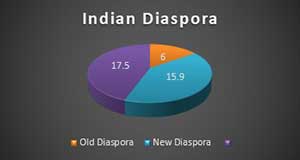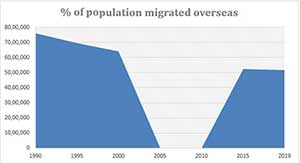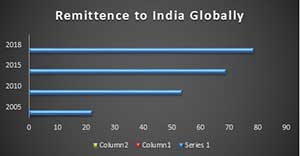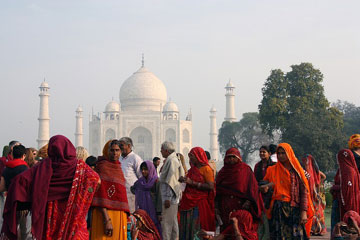The Indian diaspora before becoming one the largest in the world for overseas emigration faced many phases.
- The ancient and the medieval period
- The colonial period
- The post- colonial phases
The very early instances of Indian migration and its Diaspora starts is around the 1st century AD. The first migration from India took place with a group of migrators known as gypsies emigrated from India towards the northwest and eventually settled in Eastern Europe.
Indians have been migrating to various parts of the world from ages Indians and Indian Kingdoms have spread over across the seas immemorial. Some of the earliest emigration of Indians may be traced with civilizations like the Greek for trade and religious contacts According to Tinker (1977: 1), " The Pala’s of Bengal were in contact with the Sailendra kings of Indonesia.
In the middle ages, the Indian diaspora first started for unskilled labor. Indian merchant colony was established as early as 1610 in a place called
Volga-Tsardom of Russia. Russian chroniclers reported the presence of Hindu traders in Moscow and St Petersburg in the 18th century.
Enormous number of people who started to move which is said to be the first wave of Indian diaspora began during the early 19th century for unskilled labor and highly skilled labor after the mid-1960s.
From 1830s to 1930s the British rule and its impact on the Indian economic backwardness which resulted in unemployment. The institution of Slavery saw a ban in 1830s by the British which created critical labor shortage in sugar plantations of the British and European colonies, thus giving birth to the contract form of labor from India and other parts of Asia.
Then indenture system was introduced where a labour becomes labelled state regulated labor for 5 years with employer having rights to deny to change the employer or employment, fixed wages and so on (Kondapi 1951). Apart from the indenture form of labor in the colonial period, there were also migrants who paid their own expenses and moved outside like students, merchants and politically significant individuals.
Dating back to nineteenth century, Indian indentured labor was taken over to the British colonies in different parts of the world. The incorporation of the British Empire in India can be linked to the existence of modern Indian Diaspora all over the world.
In the early part of 20th century many Gujarati traders left for East Africa in large numbers as if it's an emulation of their ancestors.
Places like
Fiji, Mauritius, Guyana, Trinidad, Surinam,
Malaysia,
South Africa, Sri Lanka, New Zealand... leave the foot prints of Indian immigration in a peculiar way. Over two million Indian men fought on behalf of the empire in several series of wars fought abroad, including the Boer War and the two World Wars, and some remained behind to claim the land on which they had fought as their own.
Post-World War II period, most of the Indian labor and professionals scattered and it was a worldwide phenomenon. The reconstruction of Europe after the war was provided by Indian and other South Asians, particularly in United Kingdom and Netherlands. In the more recent years the physical landscape of much of the Middle East is transformed by unskilled labors from South Asia. Indians have made their presence visibly felt in professions in countries like the United States, Canada and Australia.
Post-colonial period was entirely different where migrants from the middle-class, who were skilled with Instruction in English. Educational system in the post Independent India was patterned after the British and American educational systems which produced professionals who outnumbered the availability of jobs that can absorb them. All prospective people were attracted with the available opportunities abroad. This led to professional migration mainly to the developed nations of the West- the U.S., the
U.K., and some in the Europe and Australia.
Gradually India progressed with facilitated education systems and rapid transformations in the transportation and communication. More number of Indians were highly skilled with double degree holders in the fields of Medicine,Science,Engineering etc.
Over almost three decades, between 1990-2017, India witnessed waves of skilled and unskilled labour emigration.
Old Diaspora/2nd world war-6 million
New Diaspora Data as per UN
Year 2015-15.9 million
Year 2019-17.5 million
India’s Diaspora policy has evolved over time from disconnection to active involvement in the emigration process for the country.
Indians have been migrating to various parts of the world from ages Indians and Indian Kingdoms have spread over across the seas immemorial. Some of the earliest emigration of Indians may be traced with civilizations like the Greek for trade and religious contacts According to Tinker (1977: 1), " The Pala’s of Bengal were in contact with the Sailendra kings of Indonesia.
From 1830s to 1930s the British rule and its impact on the Indian economic backwardness which resulted in unemployment. The institution of Slavery saw a ban in 1830s by the British which created critical labor shortage in sugar plantations of the British and European colonies, thus giving birth to the contract form of labor from India and other parts of Asia.
Then indenture system was introduced where a labour becomes labelled state regulated labor for 5 years with employer having rights to deny to change the employer or employment, fixed wages and so on (Kondapi 1951). Apart from the indenture form of labor in the colonial period, there were also migrants who paid their own expenses and moved outside like students, merchants and politically significant individuals.
Post-colonial period was entirely different where migrants from the middle-class, who were skilled with Instruction in English. Educational system in the post Independent India was patterned after the British and American educational systems which produced professionals who outnumbered the availability of jobs that can absorb them. All prospective people were attracted with the available opportunities abroad. This led to professional migration mainly to the developed nations of the West- the U.S., the U.K., and some in the Europe and Australia. Gradually India progressed with facilitated education systems and rapid transformations in the transportation and communication. More number of Indians were highly skilled with double degree holders in the fields of Medicine,Science,Engineering etc.
Indians travelling as international migrants globally gave rise from 7 million in 1990 and a 143% increase, according to data from the United Nations Department of Economic Affairs.




